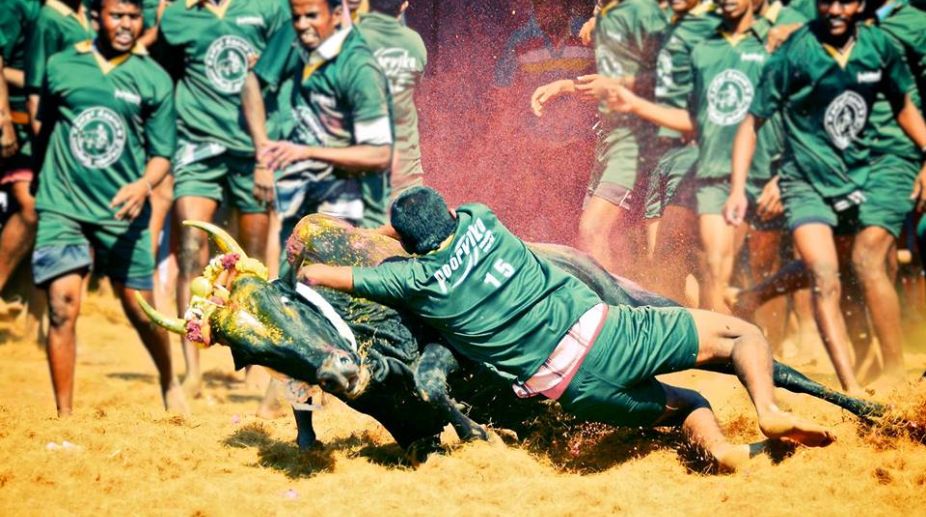Pitch for TN
Amidst the kaleidoscope of Tamil Nadu’s political landscape, the Bharatiya Janata Party (BJP) finds itself entangled in a complex web of identity, ideology, and electoral aspirations.

Jellikat (FACEBOOK)
Imagine a bullfight in which the bulls, and not the men, do all the damage — that is the South Indian jellikat, a purely indigenous sport confined to Tamil Nadu, mainly to the areas of Madurai, Ramnad and Pudukkottai. The bulls are never harmed in a jellikat, but sometimes a man dies.
It is a sport celebrated for its manly courage and swift skill, but surprisingly little known outside the districts where it has long been established. Jellikats are held only on special occasions in the countryside, and are widely advertised (traditionally by beating of drum) and always attract large crowds. Actually, there is no combat between man and beast in the sport — it is more accurately described as a bull-stopping, horn-cloth-snatching competition than as a bull-fight.
The bulls, along with their handlers, are assembled in a big, circular stockade, sometimes a hundred or more, among them perhaps one or two notoriously dangerous bulls that have not been stopped for years. The animals are often gaily decorated, and have a cloth wound fairly loosely around their horns. There is a gate in the stockade, leading to narrow lane, fenced on both sides, and giving on to open ground. The bulls are released into the lane one by one, and the men who wish to stop them are just outside the fence, which is sufficiently open to permit a man, but not a bull, to slip through. As the bull comes down the lane, the man challenging it, slips through the fence to meet it, and gauging his opportunity to the split second, throws himself bodily on the beast, grapples momentarily with it, and snatching the cloth from around its horns, springs back to safety. Sometimes the bulls eludes the man and gets away; sometimes it wounds him slightly, and occasionally fatally, but often enough the man succeeds in getting away unscathed.
Advertisement
He who des so successfully may win a substantial prize if the bull is an especially notorious one —in the old days it was even the hand of the girl he fancied — but always it was the glory and the applause that the exploit brought that mattered. It makes no difference whether the hazards are those of the exploration of space or of ageold combat between man and beast — so long as there are men, there will still be those that care for the brief moment of heroic triumph, and who are willing to chance their lives for it.
And the sport can be dangerous. These bulls are especially bred and trained for the jellikat, as carefully as for any Spanish bull-ring. They are small, compact, quick-muscled and mettle-some, with short, hard horns, animals specially trained from calfhood to go for any stranger approaching them too closely, and so sudden and fast in attack that the risk from their vicious horns is always real. Thirty-odd years ago, at a jellikat near Madurai I saw two men disemboweled within seconds, by a bull that no one had succeeded in stopping for five years — one died on the spot, and the other within an hour, but a man may linger in pain for days before succumbing.
The experienced bulls come sauntering down the lane, deceptively slow and seemingly indifferent to the crowds outside the fencing, and their challengers just within the palisade. The younger bulls that career down the narrow passage, with their heads down and a display of aggression, are much easier stopped — an expert can utilise their momentum to snatch the cloth from their horns without even bothering to grapple with them. But the old bulls that know every trick of the game advance slowly, stopping from time to time to take stock are really dangerous, for they can kill or maim a man in a flash, and are enormously powerful and vindictive. It is amazing but true that these treacherous old bulls, which the bravest and most-skilled men dare not engage, can be handled with impunity by a little boy or girl who has known them for years. Nowadays the sport is losing ground among a people rapidly being educated to new traditions of living, and who lack the time and the money to specialise in off-beat sports. But perhaps the jellikat will be revived for the spectacle it provides (especially for foreign tourists) even more than for its innate unobtrusive risks. It is certainly a sport that calls for at least as much skill and courage as the far-famed bullfight of Spain, and is in its somewhat rural way, no less spectacular and thrilling, though it is true that it is often bloodless. Perhaps that is what is against it.
This was published on 4 july 1965 in the sunday statesman
Advertisement